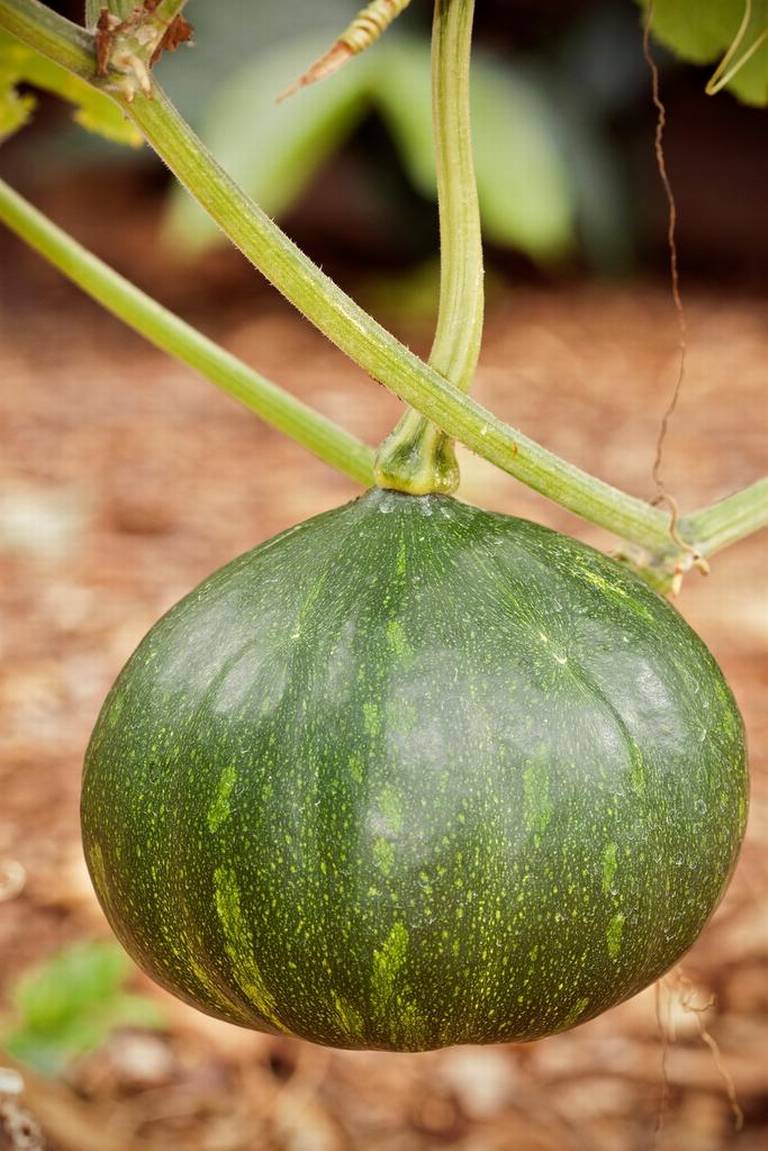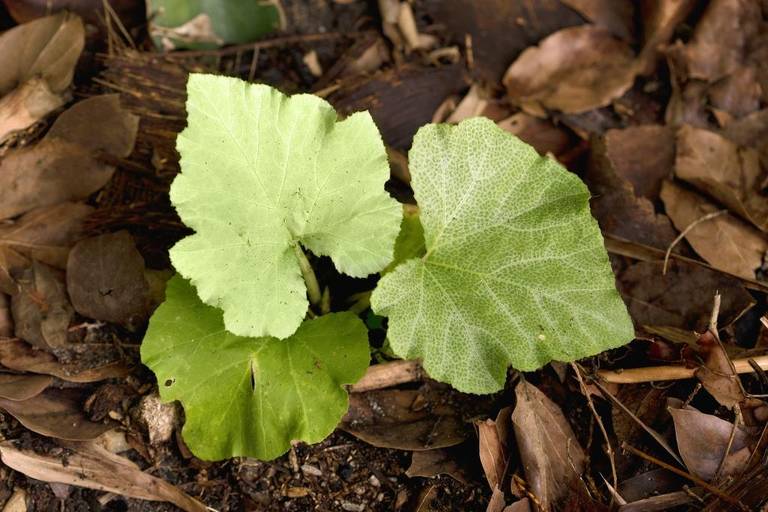Seminole pumpkin: the veggie that can stand the heat

BY KENNETH SETZER
As published in the Miami Herald, 6/18/16.
One of the few plants of its type that can endure the heat, humidity and inundation of a South Florida summer, the Seminole pumpkin offers another benefit: You can eat it.

This Seminole pumpkin needs some time yet to ripen.
The species isn’t very specific. Cucurbita moschata refers to quite a few plants that produce quite a few different squash or pumpkin-like fruits that are all varieties of C. moschata. There may be many natural hybrids, as species in this genus cross pollinate easily.
And then there are those varieties cultivated by Native North and South Americans in prehistory, and of course modern cultivated varieties. Consequently, many local variations of pumpkins, gourds and/or squash exist throughout North and South America.

Seminole pumkin plant at about two weeks old
Seminole pumpkin is of the winter squash variety, a summer grower. I tried, unsuccessfully, to grow it through winter in the past. There was no frost, so I can only guess that the little seedlings lacked enough rain and sun.
SUMMER SQUASH REFERS TO SQUASHES EATEN WHEN THE SKIN OF THE FRUIT IS STILL SOFT AND TENDER, LIKE ZUCCHINI, VERSUS WINTER SQUASH, THE FRUIT OF WHICH IS ALLOWED TO MATURE WITH THE SKIN CONSEQUENTLY BECOMING A TOUGH RIND.
By the way, summer squash refers to squashes eaten when the skin of the fruit is still soft and tender, like zucchini, versus winter squash, the fruit of which is allowed to mature with the skin consequently becoming a tough rind.
For this coming summer, I germinated some Seminole pumpkin seeds. With seeds placed just slightly under the soil, and with daily watering, the seedlings appeared in a few days. Buy seeds online or try local nurseries specializing in Florida natives.
The largest, when it grew four or five leaves, and was about five inches long, was ready for the garden.
This cute little vining annual can attain a length of 30 feet. It’s a climber, so you can plant it at the base of a trellis. The trellis used at Fairchild is only about six feet high, but of a greater width so vines can be trained along it while the fruit stays at a height where it can be reached without the need for a bucket truck. If left to grow on the ground, fruit can be raised off the soil slightly onto straw or wood to avoid rot.
At home, I planted it at the base of a tree and let it climb.
The story has made its way around that Florida’s Native Americans would plant pumpkins under a live oak, with the resulting fruit making what looked like a pumpkin tree. An Economic Botany article of 1956 supports this with a 1732 mention of the pumpkin in Florida by naturalist Mark Catesby, and famed Colonial explorer William Bartram reported “ariel” pumpkins at the St. Johns River in 1765.
THE STORY HAS MADE ITS WAY AROUND THAT FLORIDA’S NATIVE AMERICANS WOULD PLANT PUMPKINS UNDER A LIVE OAK, WITH THE RESULTING FRUIT MAKING WHAT LOOKED LIKE A PUMPKIN TREE.
The area beneath a tree may be crisscrossed with subterranean roots, so excavating may be tricky. I removed quite a few rocks, and with a little persistence made a small hole, maybe 6 inches deep and 6 inches across. I did this to amend the soil and give the seedling a strong start.
Seminole pumpkins are hungry plants. They like lots of compost and fertilizer in the form of chicken or cow manure. I filled the hole with compost. As it grows, I’ll need to add fertilizer.
I wonder why a native plant would require extra nourishment. Maybe it’s meant to be able to sprawl along the ground, with its roots accessing soil nutrients. Ah, given another lifetime, I might choose to devote it to studying the gourd family, the cucurbits, and its mysteries.
Like many other Cucurbitaceae family members, the flowers display a bright yellow-orange corolla (the petals taken collectively) with a crepe-paper texture. They are also edible. And as Julia Morton points out in Wild Plants for Survival in South Florida, the leaves also may be cooked and eaten.
With some luck, in 120 days or so, fruit will be ready to harvest. Morton states the fruit is “occurring in many forms, round, oblate, pear-shaped, or short necked. Orange when ripe with orange-yellow flesh.” At maturity, they turn a gourd-like tan. If you can’t wait, Morton indicates the young fruit, still green, “from which the flower has just fallen,” can be cooked, mashed and eaten.
The Seminole pumpkin suggests a connection to the Florida before pavement, before so-called improvement. Who would think a simple squash would link us to so much of the past? It’s pleasant to ponder.
Prepare the mature fruit as you would any squash and with luck a native Florida dish will be ready in time for Thanksgiving.
